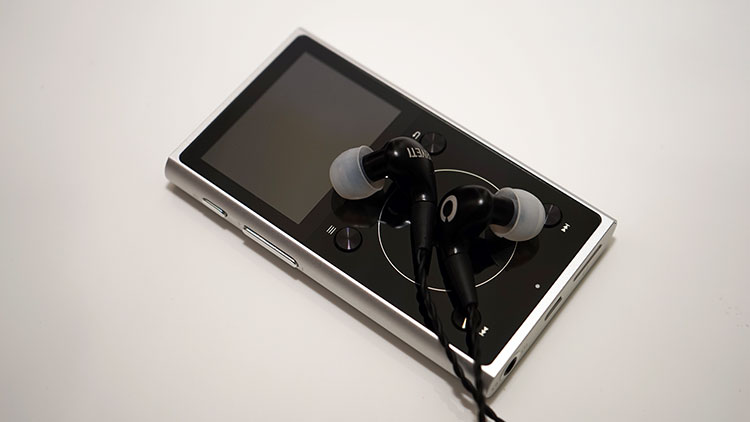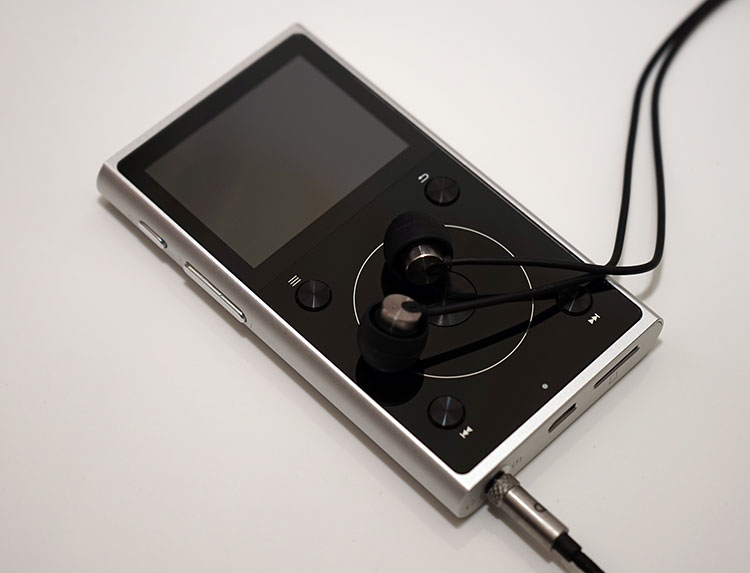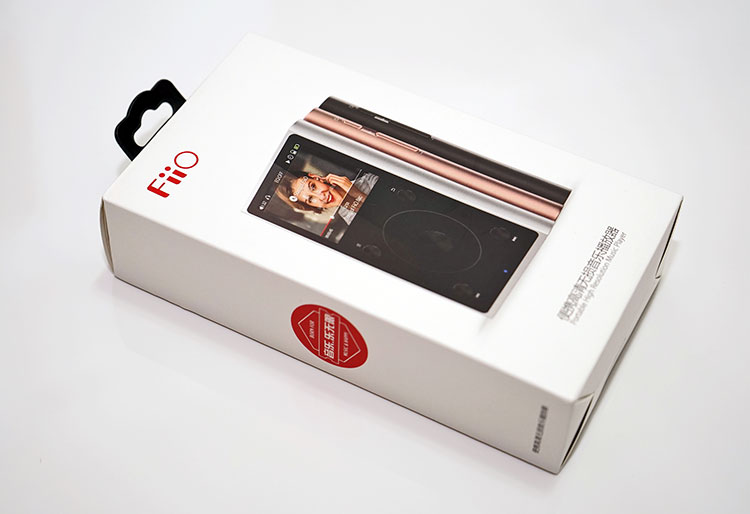Sound Impressions
Tonality
When I discussed the previous X1 I described it as a warm to neutral DAP with a thick, bass-heavy presentation and struggling for air with a narrow center focused soundstage. Reading that back it is probably not the biggest level of praise but for $99 and compared to the competition it stood its ground admirably.
The second generation of the X1 has a much more likable and slightly more balanced tonal presentation. It is still has a little warm sheen to it, it is still a musical sounding DAP but this time, it sounds less thick, less bass-heavy, with a cleaner if slightly flatter signature.
Bass
It does sound to me that they have tightened up the bass with the new TI PCM5422 DAC combined with whatever magical implementation sauce they sprinkled over the new X1 amping stage design.
It still goes as deep as the old X1, the extension is excellent but it doesn’t come across as heavy-handed and dominating as the old X1’s bass. Maybe they just dropped the -dB a touch, just enough to give it a little bit more coherence.
The bass is still north of neutral but combined with the new DAC’s slightly superior clarity I felt the new X1’s bass response had a bit more flexibility and refinement than before with a wider range of genres.
Mids
Vocals in the new X1 are once again slightly ahead of instrumental staging pulling in the soundstage a little and keeping it on the intimate side but it doesn’t sound quite as congested as before.
There are decent instrumental separation and a slightly more natural sounding timbre. Certainly, it is the most mid-focused of the X series DAPs for me. Despite its lack of micro-detail and refinement compared to the higher X DAPS those who enjoy full-sounding vocals on a budget will find a very agreeable performance from the X1 2nd Gen.
Treble
That struggle for air in the old X1 has eased up a bit also. It is not X5ii or X7 levels of extension but it does have a touch more sparkle and headroom in its delivery at the top end than before. It does not get carried away though and matched with something like the IT03 which can go either way in terms of sibilance or control the match is actually very neutral and articulate.
Matchability
Efficiency
Hybrids & BA
I actually conducted much of this review using the new iBasso IT03 hybrid IEM. This is a medium efficiency IEM, perhaps in the lower tier in terms of drivability with a 107dB sensitivity rating and an 8-ohm impedance.
Since there is no gain setting on the X1 Gen 2 I had to push the volume on the X1 G2 all the way up to around 70 digital steps (X1 has 100 in total) which is roughly only 12% lower than optimal volume settings on the ZTE Axon 7 smartphone. Granted the Axon 7 is probably the best smartphone out there in terms of audio performance (AK4490 DAC chip) but the amp is still not that powerful.
Other hybrid IEMs such as the 107dB 11-ohm Oriveti Primacy fared slightly better at 65 digital steps with the single BA Orion from Campfire Audio taking the mid-fi prize for drivability at literally half the volume of the IT03 at 35-40 steps.
Dynamic
Single dynamic driver mid-fi IEMs with low ratings fared much better than those two hybrid designs. The T20 from RHA, a 16-ohm 90dB IEM sitting quite happily at 43-46 on the X1 2nd Gen’s volume with its older brother, the T10 not that far behind at 45-48 digital steps. I also saw similar ratings for the legendary 32-ohm 108dB Sony EX1000 at 45-48 digital steps.
You will be pleased to hear all IEMs tested were hiss free on the X1 with really great low noise performance which is a testimony to FiiO’s new DAC choice selection. Tonally, my pick was the EX1000 or the RHA T20 pairing. The X1’s musical leanings seem to suit those big dynamics drivers slightly better than BA designs.
Power
Planars
HE400S
Just goes to show how inefficient the IT03 can be at times as the Hifiman HE400S drove perfectly fine on 70 – 75 digital steps, almost the exact same level as iBasso’s new hybrid IEM. That being said it doesn’t quite have the headroom and dynamics of a desktop amp or a higher-end DAP such as the X7/AM3 combo but it sounds coherent, relatively smooth sounding with very natural sounding vocals.
HE400i
You have to go a little higher for the HE400i at 80 steps but that’s still fairly manageable. The X1/HE400i pairing didn’t have the meatiest low end and I have heard the HE400i driven with more authority on bigger setups but it didn’t sound tinny or too compressed either.
PM-3
A very impressive pairing in terms of power handling. The PM-3 is actually more efficient than the IT03 with volume topping out at around 65 digital steps, a full 5 steps lower than the hybrid IEM.
The PM-3 does an adequate job with the X1, it never really hit the heights of the HE400s in terms of air and dynamics. I found the X1/HE400s better for rock genres with its more expansive midrange but for the likes of EDM such as Dash Berlin I actually enjoyed this slightly darker and thicker sounding combination.
Dynamic Headphones
Hifiman Edition S
The 18 ohm 113dB Edition S has no problems with the X1 2nd Gen pairing with optimal volume settings at 65 steps before things go uncomfortable. They also sounded fairly well driven in either closed or open mode.
Tonally, Edition S in open mode with the X1 2nd Gensounded the more natural and authoritative of the two possible tonal settings with the closed mode sounding a touch too bright for my taste. Sibilance if fairly well controlled on open mode also with the X1 2nd Gen and that heavier low end the open mode paired well with the X1 2G’s more refined yet musical presentation.
Philips A5-Pro
This 16-ohm 105dB headphone is an excellent pairing for trance fans and in fact, anyone who wants something with a solid low-end performance yet with a quick enough tempo for high energy BPM. No issues at all for driving, in fact, it was the easiest of all the headphone pairings to drive at just 50 steps on the X1 2nd Gen’s volume setting. Nothing sounded tinny, lacking in dynamics or horribly grainy. Overall this is a dark to neutral presentation and heavy-hitting musical pairing overall.
Bluetooth Performance
Boot up
This is something FiiO needs to focus on. Turning on BT during playback is very slow indeed, sometimes taking up to 20 seconds to become operational. It is a touch faster if no music is playing though but not by much.
RM1
Functional connections with FiiO’s own BT products went very smoothly though with the RM1 showing up right away and fairly easy to operate though it does not seem to be able to navigate menus like Android or iOS type BT remote controls.
Other Smartphones
Connecting to my smartphone BT was a bit more problematic. The X1 2nd Gen could not see the smartphone but the smartphone could see and connect to the X1 though only the “contacts” service was offered and not audio services.
BT Headphones
Stance S1+ & Creative E5
Using the Stance S1+ BT headphone pairing was relatively quick and easy to do with the X1 2nd Gen so no issues there. Despite not utilizing aptX technology the sound at 1m or less was actually pretty smooth and musical sounding. The Stance S1+ is probably the best Bt headset out there for the money right now and whilst it is not the heaviest hitting can its got an excellent midrange.
The X1 2G performed quite well in that respect and not once did the Stance S1+ sound unduly muffled or compressed which can often be the case on non-aptX connections (AK100 mk1 as an example).
The distance achieved was approximately 5-7m with a single wall barrier and roughly 2-3m with two wall barriers which is better than the AK100 Mk1 AD2P performance but slightly shorter in range than the Creative E5 aptX BT 4.0 signal
Smartphones
Distance and quality of the signal are also on par with my ZTE Axon 7 smartphone which also uses BT 4.0 but without aptX capability. Tonally the X1 Gen 2 had a bit more bite in the low end than the smoother and politer Axon 7 using the Stance S1+. I could happily use either as the detail and resolution of the ZTE is very competitive (AKM AK4490 DAC chip).
Should I Upgrade?
X1 Gen 1
The answer depends on what you see as most important to you. If it is based on audio performance and feature sets then it is a firm yes. The X1 Gen 2 is more resolving, more balanced, and more interesting to listen to than the rather heavier and thicker sounding X1 Gen 1. It has more air, more headroom, and better-behaved bass performance and much easier to work with over a broader range of IEMs and headphones.
The new touch-sensitive touch wheel is so much slicker, the form factor is more comfortable and the physical looks suitably enhanced over the X1 Gen 1. The deep sleep standby and improved battery performance are also a logical enhancement bringing it up to par with the X3 Gen 2 in that respect.
If UI and speed are more important then the X1 Gen 1 does have a slight edge at the time of writing. It will be interesting to see if there will be improvements in the UI speed, particularly with the use of Bluetooth which is a double-edged sword with fw1.2.
Audio-wise it does not have aptX 4.0 but it is still quite a capable performer within short ranges but it slows everything down considerably on the UI. You get the feeling the processor is being pushed to the limit.
X3 Gen 2
The question now is should you buy into the new X1 Gen 2 or get the X3 Gen 2. To be honest, the X3 Gen 2 is still the more resolving of the two. It has a more balanced signature, as well as having the ability to decode DSD and possessing a DAC-out feature that the X1 does not have. It also has a speedier processor than the newer X1 2nd Gen and in general, it is faster to use.
The new X1 does have BT which the older X3 does not and the new form factor is likely to be the way of future DAP revisions from FiiO so it does have that in its favor. Also, the DAC in the X1 is superior to my ears than the older X1. The new X1, despite being a budget entry-level DAP is more competitive compared to the X3ii but it is not yet as resolving.
The price gap between the two is a lot closer than when the X1 Gen 1 originally came out with street prices of the almost 18 months old X3ii a lot softer than its $199 MSRP and there is always the raging certainty that the X3ii will be upgraded by next year to something even better.
Our Verdict
The FiiO X1 2nd Gen is a distinct improvement over the first X1 in terms of sound. The original X1 was just ok for me in the scheme of things and I always gravitated to the X3 gen 2 if I wanted a small portable player. However, the X1 Gen 2 sounds a lot more balanced now, the touch-sensitive wheel a lot slicker to use and BT does add some real value to the package.
However, as with most things these days, there does need to be some attention paid to the speed of the X1 in terms of media scanning and operations in general when BT is turned on. The standby mode is a wonderful feature now to have in the X1 but combined with BT turned on it really becomes very slow to turn itself back on. You do get the sense subsequent firmware are not far behind and issues like this will be remedied in the near future.
Overall though I think the X1 2nd Gen offers more for $99 than its predecessor without encroaching too much on the product position of the X3ii. I think FiiO has been very careful in that respect and kudos to them for keeping costs down for the new additional features and offering a more evolved budget level DAP than before.
X1 2nd Gen Technical Specifications
| General Specifications | |||
| Model/Number | All new X1 / FX1221 | Headphone out (PO) | 3.5mm headphone output jack |
| Color Available | Silver/Black/Rose gold | Headphone Impedance Range | 16~100 Ω |
| Dimensions | 97mm×55.5 mm×12 mm | Volume control type | 100 steps digital potentiometer |
| Weight | 102 g | Bass Boost | N/A |
| Display Screen | TFT 320×240 | Treble | N/A |
| Analog Audio Output Jack(LO) | 3.5 mm headphone output jack | Balance | 5 dB |
| Digital Audio Output Jack | N/A | Gain Selection | N/A |
| USB DAC | N/A | Equalizer | 7-band equalizer (±6dB) |
| Chips used | SoC: JZ4760B , DAC: PCM5242, LPF: OPA2322, OP: ISL28291 | ||
| Partial Performance Parameters for Line Output | |||
| THD+N | ≤ 0.003% (1 kHz) | SNR | ≥115 dB (A-weighted) |
| Frequency Response | 5 Hz~60 kHz (-3dB) | Dynamic range | ≥107 dB |
| Crosstalk | ≥ 101 dB (10 KΩ/1 kHz) | Line output Level | 1.7 Vrms (10 KΩ/1 kHz) |
| Partial Performance Parameters for Headphone Output | |||
| Output Power 1 | ≥ 90mW (16 Ω/THD+N<1%) | Output Impedance | <1Ω(32Ω loaded) |
| Output Power 2 | ≥ 70 mW (32 Ω/THD+N<1%) | Crosstalk | ≥72 dB (1 kHz) |
| Output Power 3 | ≥ 8 mW (300 Ω/THD+N<1%) | THD+N | ≤ 0.003% (1 kHz) |
| Frequency Response | 5 Hz~60 kHz (-3dB) | MAX output voltage | >4.0 Vp-p |
| SNR | ≥113 dB (A-weighted) | MAX output current | >130 mA(For reference) |
| Power and Battery | |||
| Power | Recommend DC5V 2A | Battery Capacity | 1800 mAh |
| Charge Display | Red light charging, green light fully charged | Battery Display | Yes |
| Battery Life | >12 h | Charging Time | <3 h (DC5V 2A) |
| Battery Life Test Conditions | |||
| Screen | OFF | Load | M3 open earbuds (27 Ω) |
| Volume | 39 | EQ | OFF |
| Test File | MP3 44.1kHz/16bit (Download link) | ||
| Audio Format Supported | |||
LosslessAPE(Fast): 192 kHz/24 bit; Lossy compressionMP3、AAC、WMA、OGG, |
|||





